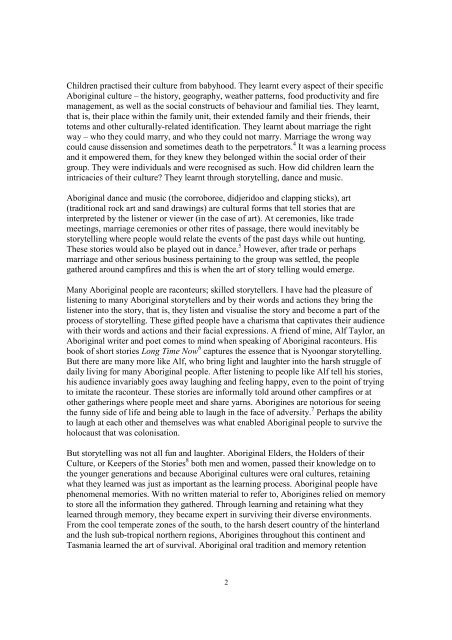Aboriginal Storytelling and Writing Rosemary van den Berg ...
Aboriginal Storytelling and Writing Rosemary van den Berg ...
Aboriginal Storytelling and Writing Rosemary van den Berg ...
- No tags were found...
You also want an ePaper? Increase the reach of your titles
YUMPU automatically turns print PDFs into web optimized ePapers that Google loves.
Children practised their culture from babyhood. They learnt every aspect of their specific<strong>Aboriginal</strong> culture – the history, geography, weather patterns, food productivity <strong>and</strong> firemanagement, as well as the social constructs of behaviour <strong>and</strong> familial ties. They learnt,that is, their place within the family unit, their extended family <strong>and</strong> their friends, theirtotems <strong>and</strong> other culturally-related i<strong>den</strong>tification. They learnt about marriage the rightway – who they could marry, <strong>and</strong> who they could not marry. Marriage the wrong waycould cause dissension <strong>and</strong> sometimes death to the perpetrators. 4 It was a learning process<strong>and</strong> it empowered them, for they knew they belonged within the social order of theirgroup. They were individuals <strong>and</strong> were recognised as such. How did children learn theintricacies of their culture? They learnt through storytelling, dance <strong>and</strong> music.<strong>Aboriginal</strong> dance <strong>and</strong> music (the corroboree, didjeridoo <strong>and</strong> clapping sticks), art(traditional rock art <strong>and</strong> s<strong>and</strong> drawings) are cultural forms that tell stories that areinterpreted by the listener or viewer (in the case of art). At ceremonies, like trademeetings, marriage ceremonies or other rites of passage, there would inevitably bestorytelling where people would relate the events of the past days while out hunting.These stories would also be played out in dance. 5 However, after trade or perhapsmarriage <strong>and</strong> other serious business pertaining to the group was settled, the peoplegathered around campfires <strong>and</strong> this is when the art of story telling would emerge.Many <strong>Aboriginal</strong> people are raconteurs; skilled storytellers. I have had the pleasure oflistening to many <strong>Aboriginal</strong> storytellers <strong>and</strong> by their words <strong>and</strong> actions they bring thelistener into the story, that is, they listen <strong>and</strong> visualise the story <strong>and</strong> become a part of theprocess of storytelling. These gifted people have a charisma that captivates their audiencewith their words <strong>and</strong> actions <strong>and</strong> their facial expressions. A friend of mine, Alf Taylor, an<strong>Aboriginal</strong> writer <strong>and</strong> poet comes to mind when speaking of <strong>Aboriginal</strong> raconteurs. Hisbook of short stories Long Time Now 6 captures the essence that is Nyoongar storytelling.But there are many more like Alf, who bring light <strong>and</strong> laughter into the harsh struggle ofdaily living for many <strong>Aboriginal</strong> people. After listening to people like Alf tell his stories,his audience invariably goes away laughing <strong>and</strong> feeling happy, even to the point of tryingto imitate the raconteur. These stories are informally told around other campfires or atother gatherings where people meet <strong>and</strong> share yarns. Aborigines are notorious for seeingthe funny side of life <strong>and</strong> being able to laugh in the face of adversity. 7 Perhaps the abilityto laugh at each other <strong>and</strong> themselves was what enabled <strong>Aboriginal</strong> people to survive theholocaust that was colonisation.But storytelling was not all fun <strong>and</strong> laughter. <strong>Aboriginal</strong> Elders, the Holders of theirCulture, or Keepers of the Stories 8 both men <strong>and</strong> women, passed their knowledge on tothe younger generations <strong>and</strong> because <strong>Aboriginal</strong> cultures were oral cultures, retainingwhat they learned was just as important as the learning process. <strong>Aboriginal</strong> people havephenomenal memories. With no written material to refer to, Aborigines relied on memoryto store all the information they gathered. Through learning <strong>and</strong> retaining what theylearned through memory, they became expert in surviving their diverse environments.From the cool temperate zones of the south, to the harsh desert country of the hinterl<strong>and</strong><strong>and</strong> the lush sub-tropical northern regions, Aborigines throughout this continent <strong>and</strong>Tasmania learned the art of survival. <strong>Aboriginal</strong> oral tradition <strong>and</strong> memory retention2



![Dream and Nightmare in William Gibson's ... - [API] Network](https://img.yumpu.com/49298598/1/184x260/dream-and-nightmare-in-william-gibsons-api-network.jpg?quality=85)
!['Fuck All Editors': The Ern Malley Affair and Gwen ... - [API] Network](https://img.yumpu.com/42446228/1/184x260/fuck-all-editors-the-ern-malley-affair-and-gwen-api-network.jpg?quality=85)
![Polona Petek - [API] Network](https://img.yumpu.com/40542952/1/190x245/polona-petek-api-network.jpg?quality=85)
![to download as a PDF. - [API] Network](https://img.yumpu.com/35170825/1/184x260/to-download-as-a-pdf-api-network.jpg?quality=85)
![Edward Koiki Mabo: The Journey to Native Title - [API] Network](https://img.yumpu.com/33197148/1/184x260/edward-koiki-mabo-the-journey-to-native-title-api-network.jpg?quality=85)
![Gallipoli, Kokoda and the Making of National Identity - [API] Network](https://img.yumpu.com/31766380/1/184x260/gallipoli-kokoda-and-the-making-of-national-identity-api-network.jpg?quality=85)
![Indigenous Knowledge and Pharmaceuticals - [API] Network](https://img.yumpu.com/24108846/1/184x260/indigenous-knowledge-and-pharmaceuticals-api-network.jpg?quality=85)
![Ferals: Terra-ism and Radical Ecologism in Australia - [API] Network](https://img.yumpu.com/13809010/1/184x260/ferals-terra-ism-and-radical-ecologism-in-australia-api-network.jpg?quality=85)
![Big Chief Little Wolf: Wrestling, Radio and Folklore in ... - [API] Network](https://img.yumpu.com/12204748/1/184x260/big-chief-little-wolf-wrestling-radio-and-folklore-in-api-network.jpg?quality=85)
![Dark Tourism and the Celebrity Prisoner - [API] Network](https://img.yumpu.com/4348795/1/184x260/dark-tourism-and-the-celebrity-prisoner-api-network.jpg?quality=85)